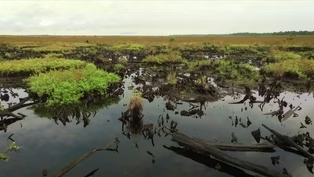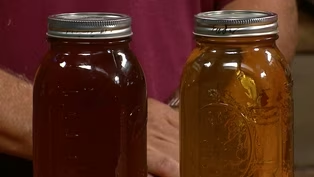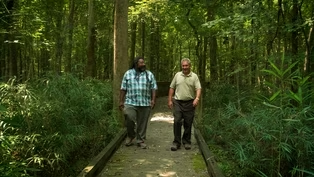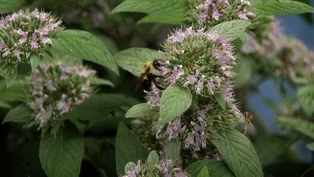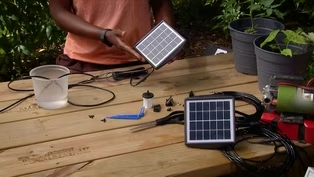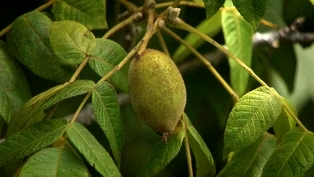Virginia Home Grown
Deer defense
Clip: Season 23 Episode 6 | 6m 31sVideo has Closed Captions
Discover features that help invasive plants spread
Curator of the State Arboretum of Virginia, T’ai Roulston, explains that many invasive plants spread more easily because they do not encounter the same deer pressure as native plants. Many non-natives are thorny or have a bad taste that deer avoid. Featured on VHG episode 2306; August 2023.
Problems playing video? | Closed Captioning Feedback
Problems playing video? | Closed Captioning Feedback
Virginia Home Grown is a local public television program presented by VPM
Virginia Home Grown
Deer defense
Clip: Season 23 Episode 6 | 6m 31sVideo has Closed Captions
Curator of the State Arboretum of Virginia, T’ai Roulston, explains that many invasive plants spread more easily because they do not encounter the same deer pressure as native plants. Many non-natives are thorny or have a bad taste that deer avoid. Featured on VHG episode 2306; August 2023.
Problems playing video? | Closed Captioning Feedback
How to Watch Virginia Home Grown
Virginia Home Grown is available to stream on pbs.org and the free PBS App, available on iPhone, Apple TV, Android TV, Android smartphones, Amazon Fire TV, Amazon Fire Tablet, Roku, Samsung Smart TV, and Vizio.
Providing Support for PBS.org
Learn Moreabout PBS online sponsorshipWell T'ai, I will tell you, you've brought the most unique set of plants to share.
When we think about invasive plants and plants that are, say, have their attributes to kind of find their way in an ecosystem or in their environment, these plants you have on the table sure have their their ways, which is why I have gloves on.
(laughing) >>And why I probably should have my gloves on.
>>Yes, so to me, what is your first one that you wanna start with?
And I'll say the worst one.
>>Yeah, so let's start with a bit of autumn olive here.
So this is one of the plants that people may very well know.
So usually you're trying to figure out how to get plants to grow.
This is one of the plants you're trying to figure out how to get rid of.
Now, what is it about these invasive plants that really change our ecosystems?
How do they survive the different pressures so much better than everything else?
Well, the first thing they have to survive is deer.
So deer are a major, major force in our suburban areas, our forested areas, our open areas.
And so almost all the invasive plants have really strong thorns there.
So that's their way of getting around the, trying to avoid the deer.
>>Exactly.
>>They're making it a little unpalatable.
And then how do they find all of those places?
How does the autumn olive get everywhere?
And the berries that are on here, the birds are very happy to go and consume the berries, and then leave them wherever they go.
>>Wherever they go, yes.
>>So that's, and then one other thing to notice is that most of the leaves here of the autumn olive, and you'll see this with some of the other plants, there's very little insect damage.
>>True, true.
>>So they're just not suffering much insect damage, which also means that they're not feeding our insects, which means that those insects are not getting anything from them to then feed other organisms.
>>Kind of a lost space in the ecosystem.
>>It really is, might as well be plastic plants, out there making little shaded areas, because they're not feeding very much.
>>Well our next one here, let's move on.
I'm gonna do the glove part, and I'll bring it on here.
This is one a lot of people love.
>>Yeah, so this is osage orange.
So this is a, it's a plant that's very common around here.
Now, it's actually native to North America, but only to panhandle Oklahoma, Texas area.
But it got moved around to be living fence posts.
And it's very, very persistent in our landscapes.
Now, so if you know those big green balls that are the fruit you see in the fall that nothing can eat, that's the osage orange.
And again, you'll notice the leaves have no insect damage on them.
And if you look closely, you'll find that they are also completely loaded with thorns.
So they are, in the same way as the autumn olive, well, well defended.
>>Yes, smart plant, but let's have him go back to where he belonged in my mind.
Well, this one here is not one most people know about.
>>No, and hopefully it stays that way.
So this is buckthorn.
So it is only invasive in a few parts of Virginia, but anybody from the upper Midwest will know it well as the scourge of the upper Midwest.
So this is, again, leaves mostly without damage.
And then all of the little branches have very sharp thorns on them.
They have blueberries in the fall that are also dispersed by the birds.
And just like everything that we've looked at so far, if you go, and they get clipped off, or something gets bush hogged, they just sprout right back, right back up.
So they're persistent in not being consumed, persistent, even if you go ahead and and chop 'em off.
>>Yeah, people don't realize that many of our invasive plants came here because they have attributes that gardeners liked.
We've kind of built, created our own problem.
But when we talk about, to me, persistent plants, I wanna pull this baby out right here, which I think is one of the worst plants to be able to manage as an invasive in trying to remove it from the environment in any way, shape, or form.
>>Yeah, absolutely.
So this is the Tree of Heaven, or Ailanthus.
And this is, it's getting a lot of publicity now because of spotted lantern fly, this is the main host for spotted lantern fly, which is spreading very quickly through the US.
>>It's coming south, it's here in Richmond.
>>It's all over up at the arboretum.
Now this plant is a little different than the other ones in that if you look, you don't see any spines.
That is not it's a little secret formula.
Here, the secret formula is really in the leaves.
So highly toxic compounds in the leaves that make it unpalatable to insects.
Again, you see nothing's feeding on the leaves.
But also unpalatable to deer.
And so they, the deer, don't have much to do with it either.
I mentioned with the other plants, if you chop 'em, they resprout.
Well if you can, this is one that's been chopped off previously.
And then just where you chopped it once, now we've got two, two stems coming out.
And it will just do that over and over again.
So you can get exponential stem growth that way on Ailanthus.
>>Exactly, which is why you have to use a systemic approach to control this plant.
Well, we've got one minute left, so let's bring over two of our non-natives.
I mean, it's two of our natives, excuse me.
>>Yeah, so about the only trees that you see coming up amidst all of these invasives, and surviving the deer, are ones that have the same characteristics, thorns.
So this is our black locust right here.
But then if you look at some of the leaves, you see lots of bites, so it's actually being fed upon by insects.
>>Which is really encouraging.
And then this one, oh my.
>>And then this one.
Now this is another one of our natives, honey locust.
I think you can see what it's claim to fame is.
So yeah, those are the daggers of the thorn world there.
So that's what it takes to be able withstand that deer pressure and make it in these little islands of invasive plants.
So only a couple of our natives are actually able to do that, withstand it.
>>People need to realize that plants do have mechanisms to be able to survive, and thorns and prickles are just some of these mechanisms.
So I thank you for bringing these to light, and also for sharing the importance of how our native plants are being utilized by the insects.
And the non-natives were nice and clean and green.
So thank you very much, T'ai.
>>You're welcome.
Video has Closed Captions
Clip: S23 Ep6 | 26m 46s | Discover unique plants and ecosystems being protected in Virginia! (26m 46s)
Video has Closed Captions
Clip: S23 Ep6 | 6m 48s | Conservation in the heart of the swamp (6m 48s)
Great Dismal Swamp National Wildlife Refuge
Video has Closed Captions
Clip: S23 Ep6 | 7m 53s | Tour a forested wetland ecosystem and learn how it is managed (7m 53s)
Video has Closed Captions
Clip: S23 Ep6 | 2m 45s | Healthy habitats start by supporting insect life (2m 45s)
Video has Closed Captions
Clip: S23 Ep6 | 2m 14s | Use solar power to save electricity and keep your plants watered (2m 14s)
Video has Closed Captions
Clip: S23 Ep6 | 8m 22s | Learn about conservation of a rare tree and research on rebuilding forests (8m 22s)
Providing Support for PBS.org
Learn Moreabout PBS online sponsorship

- Home and How To

Hit the road in a classic car for a tour through Great Britain with two antiques experts.












Support for PBS provided by:
Virginia Home Grown is a local public television program presented by VPM
